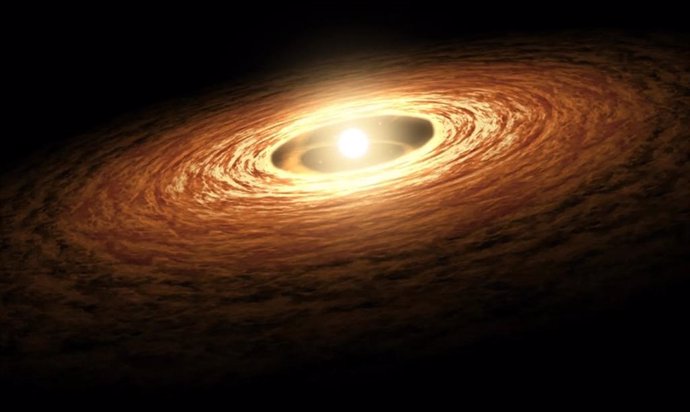This is an artist’s impression of a young star surrounded by a disk of gas and dust. – NASA/JPL-CALTECH
June 7 () –
Observations with the James Webb telescope of the disk of gas and dust in a young star reveal the largest number of carbon-containing molecules yet observed in a disk of this type.
According to the authors, these findings have implications for the potential composition of planets that could form around this star.
Rocky planets are more likely to form around low-mass stars than gas giants, making them the most common planets around the most common stars in our galaxy. Little is known about the chemistry of these worlds, which may be similar or very different to that of Earth. By studying the disks from which these planets form, astronomers hope to better understand the process of planetary formation and the compositions of the resulting planets.
Planet-forming disks around very low-mass stars are difficult to study because they are smaller and fainter than disks around high-mass stars. A program called MIRI (Mid-Infrared Instrument) Mid-INfrared Disk Survey (MINDS) aims to use the Webb’s unique capabilities to build a bridge between the chemical inventory of disks and the properties of exoplanets.
“Webb has better sensitivity and spectral resolution than previous infrared space telescopes,” he explained. it’s a statement lead author Aditya Arabhavi of the University of Groningen in the Netherlands. “These observations are not possible from Earth, because the disk’s emissions are blocked by our atmosphere.”
In a new study, this team explored the region around a very low-mass star known as ISO-ChaI 147, a star between 1 and 2 million years old that weighs only 0.11 times as much as the Sun. The spectrum revealed by Webb’s MIRI shows the richest hydrocarbon chemistry observed to date in a protoplanetary disk: a total of 13 different carbon-containing molecules. The team’s findings include the first detection of ethane (C2H6) outside our solar system, as well as ethylene (C2H4), propyne (C3H4) and the methyl radical CH3.
“These molecules have already been detected in our solar system, such as in comets such as 67P/Churyumov–Gerasimenko and C/2014 Q2 (Lovejoy),” Arabhavi added. “Webb allowed us to understand that these hydrocarbon molecules are not only diverse but also abundant. It is amazing that we can now see the dance of these molecules in planetary cradles. It is a very different planetary formation environment than we usually imagine.”
The team indicates that these results have big implications for the chemistry of the inner disk and the planets that could form there.. Since Webb revealed that the gas in the disk is so rich in carbon, it is likely that there would be little carbon left in the solid materials from which the planets would form. As a result, the planets that could form there could ultimately be carbon poor. (The Earth is considered to be carbon poor.)
“This is profoundly different from the composition we see in the disks around solar-type stars, where oxygen-carrying molecules predominatelike water and carbon dioxide,” added team member Inga Kamp, also from the University of Groningen. “This object establishes that this is a unique class of objects.”
“It’s incredible that we can detect and quantify the amount of molecules that we know well on Earth, such as benzene, in an object that is more than 600 light years away,” added team member Agnés Perrin of the National Science Center. Scientific Research in France.











![[Img #74136]](https://thelatestnews.world/wp-content/uploads/2024/10/Life-associated-with-ice-on-Mars-300x200.jpg)
Add Comment